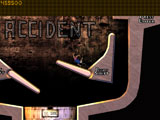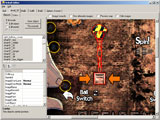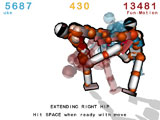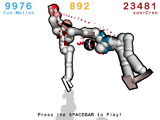New Footage of Valve’s Portal
Valve has shown the first new footage from Portal since their initial announcement. This new video is shakeycam footage from GC 2006:
Amazing Physically-Driven Fighting Game
I haven’t been this excited about a video game since I first discovered Ski Stunt Simulator. Toribash is a turn-based physics fighting game. The majority of fighting games rely on pre-built, unchanging animations. Although newer titles are incorporating motion blending and even including layers of physics simulation, the underlying motion is still keyframe based. Toribash does away with keyframes entirely, and the results are fantastic.
Controlling Your Character
Okay, so what exactly is happening in the above video? I usually stay away from describing a game in too much detail, but Toribash deserves an explanation. As I mentioned in the intro, the game is turn-based; each match is broken down into segments of time. While time is paused, you can set the behavior of your ragdoll’s joints: extend, contract, hold, or relax. So, for instance, you could raise your knee to kick by contracting both your hip and your knee. Check out their tutorial video for an idea:
Other games have attempted to implement full body, physics-based control mechanisms. The problem lies in the complication of movement. As a designer, you either need to simplify the control mechanism, automate some aspect of the process, or rely on convoluted controls. It’s a very hard problem to solve for a real-time game.
And that’s the brilliance of Toribash. They didn’t attempt to solve the complexity problem. It can take a full 20 seconds to set up your punch, kick, or grab just the way you want it. Because everything is turn-based, though, there isn’t any real penalty to this for the player. They’re given enough time to create very complex maneuvers.
Rock Paper BOO-YA!
Toribash is primarily a multiplayer game. It has a single-player mode, but there isn’t any AI to play against. You simply control two ragdolls simultaneously. While playing by yourself can be fun for setting up ridiculous replays, the real fun starts when you play a match against someone else. The default server lineup offers a variety of game settings (the server sets the amount of time that passes each turn, and the total time per match). The longer turn settings, 70 frames or so, have a very apparent rock-paper-scissors feel to them. Properly predicting and counteracting your opponent’s moves becomes a huge part of the strategy.
All of the default servers have disqualification turned on, which means that a player loses if they touch the ground with anything except their hands or feet. Most servers leave the default of enabling dismemberment, too, so a valid strategy is to literally tear off someone’s arm and throw it on the ground. Instant disqualification!
We played some matches here with disqualification turned off, and it was an interesting dynamic. It’s much harder to turn a match over, though, but the ensuing brawls were rather entertaining for their brutality (and I’m talking Dan-in-the-thoroughfare quality brutality, sans eye gouging).
I’m Hooked
Every match in Toribash is a little different. You quickly learn a variety of opening styles, but even slight changes in your ragdoll’s forces will produce completely different results. There’s a huge amount of variety waiting in the wings, too–even something as simple as letting the player choose an opening stance would modify the gameplay significantly. The engine allows for an impressive array of moves, as their promo video shows:
I don’t have a lot of negative things to say about Toribash. It’s a remarkable implementation of a very solid concept. The controls are a little difficult to learn–give up on the keyboard keys and use the mouse wheel and right button–but on the whole the game is very approachable. It’s most fun to learn locally with some friends, so put up your own server (Linux only, for now). If you can play with other people who are just learning, the frustrations of your failures will be a lot more hilarious than if you were getting your ass handed to you online.
Let the Fighting Begin!
The game is free, too, and it’s a tiny download. Give it a shot, and don’t give it up on it too soon. It takes a bit to get into, but once you’re in you’ll be having a blast.
Download Toribash Game (9.1 MB) [mirror]
Head on over to the official Toribash website for news, downloads, and forums.
Related Posts:
- Toribash Updates to 1.98
- Toribash Gets Visual Overhaul
- Toribash Updates, Releases Multiplayer Video
- Toribash 3.0 Released!
- Toribash 2.0 Released
Ragdolls on a Pinball Table
Factory Pinball, “the ragdoll pinball game”, should really have just called itself Ragdoll Pinball. The name alone would perfectly communicate the game concept. Factory Pinball was created by XZM Productions, a team of three, for the Assembly ’05 game development competition. Although the game is a bit self-explanatory, here’s their readme.txt description for good measure:
Factory Pinball is a customizable ragdoll based physics pinball game. The objective is to hit the “ball” with the paddles and keep it from falling down.
Pinball Goodness!
Factory Ragdoll isn’t just a physics test with some paddles. The developers created a complete, if somewhat simplistic, pinball experience. You have a scoring system, bumpers, spinners, and various letters to light up. There are challenges, too–a switch could trigger “hit the crate 15 times in 90 seconds”, for instance. All in all it feels like a very authentic pinball experience (although no multiball?).
The physics are fairly standard. The simulation is stable, even at high speeds, and the ragdolls bounce around as expected. The “ball” starts out as a human ragdoll, and occasionally swaps to other ragdolls, such as a cow or giraffe. Although the various ragdolls have differing geometry, the net effect of their behavior is pretty similar. You don’t need to change up your strategy if you’re dealing with the cow rather than giraffe, for instance.
Visual Muddiness
What bugs me most about Factory Pinball are actually the graphics. Granted, they were done by one person, and probably under a brutally tight schedule, but the contrast is very muddy. It’s hard to visually track the character, and the obstacles blend in with the background. Sharper contrast would definitely serve the game well.
Included Editor
My criticism of the artwork is stopped short by the available editor, though. If I really wanted to change the art, or design new obstacles, or even an entire table, I could. The editor tool is a little clunky–no undo, no contextual menu, little documentation–but if one was determined to make something I’m sure it’s possible.


(Factory Pinball Game Screenshots)
Free Game Download
The game and its editor have been released as a free download, so check them out! Factory Pinball is a solid implementation of a neat concept. There’s certainly a lot of headroom in the design–I’d love to see the ragdoll pinball concept fleshed out even more.
Download Factory Pinball Game (10.5 MB) [mirror]
Download Editor (7.2 MB) [mirror]
The Factory Pinball webpage is awfully sparse, but here’s the link for completeness. Thanks to Ben Clark for emailing me the link!
Related Posts:
- List of Physics Games
- A Chorus of Physics Games: Bounce Symphony
- Jupiter Brutally Beaten, Pluto Still at Large
- Gish + Pinball + Amazing Art = Gumboy!


 (Rate this game! 1,322 votes, average: 4.23 out of 5)
(Rate this game! 1,322 votes, average: 4.23 out of 5)

 My name is Matthew Wegner, and this site is dedicated to physics games.
My name is Matthew Wegner, and this site is dedicated to physics games.